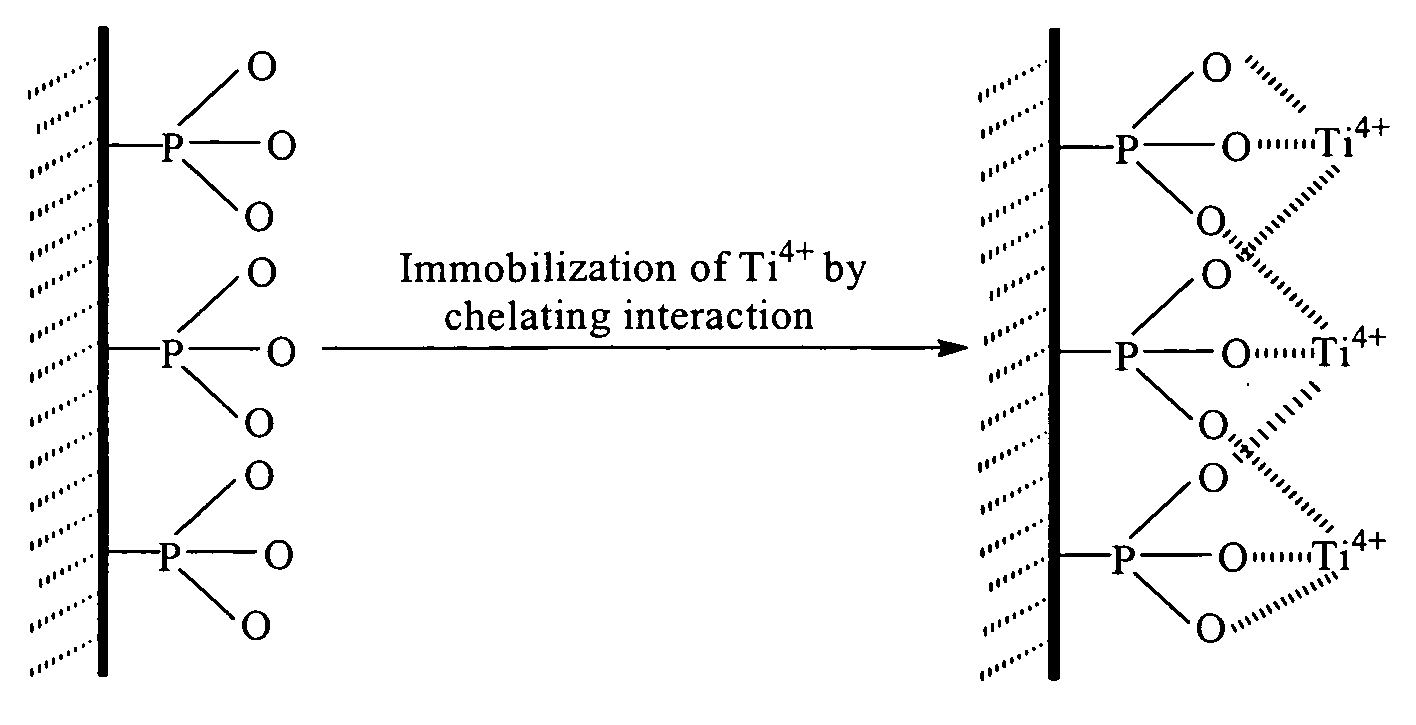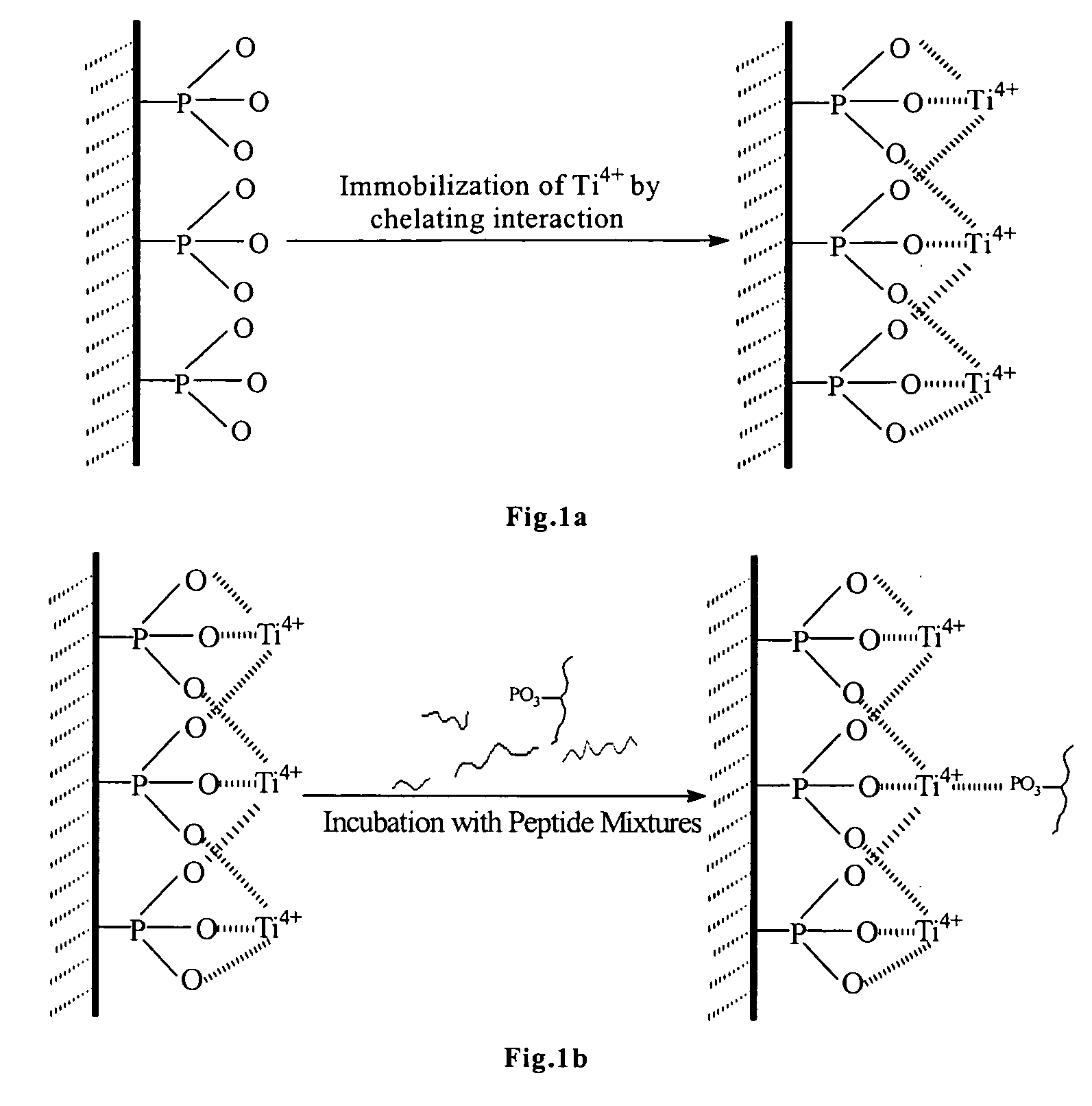Immobilized titanium ion affinity chromatography material and its preparation and application
- Summary
- Abstract
- Description
- Claims
- Application Information
AI Technical Summary
Benefits of technology
Problems solved by technology
Method used
Image
Examples
Example
EXAMPLE 1
Preparation of Ti4+-IMAC Based on Polymer
[0037]Polymer containing phosphate group was prepared by free-radical co-polymerization of functional monomer containing phosphate group and cross-linker. Subsequently the obtained polymer was incubated with titanium ion solution to obtain the Ti4+-IMAC, which was further applied to isolate and enrich phosphopeptides. The first step to prepare such polymer is to prepare polymer reaction solution. Functional monomers and cross-linkers are the main components and form polymer framework after polymerization reaction. To adjust the polymer's chemical and physical properties, various monomers can also be used, wherein, at least one monomer containing phosphate group. Porous material has large surface area resulting in high adsorption capacity. In order to prepare porous polymer, porogenic solvents, which is organic solvent and don't take part in polymerization reaction, are added in the reaction solution. Pore will be formed due to spaces...
Example
EXAMPLE 2
Preparation of Ti4+-IMAC Based on Inorganic Affinity Material
[0041]MCM-41 is a type of inorganic mesoporous molecule sieve, which is synthesized by hydrothermal self-organized method interacting by both organic leading compounds (surfactant) and organic species (monomer or oligomer) to form hexagonal crystal mesoporous molecule sieves. After removing the organic leading compounds by heat treatment or chemical methods, material called MCM-41 mesoporous molecule sieve obtained. It has hierarchically organized structure such as nanometer, micrometer and micrometer level. MCM-41 in nanometer level has honeycomb porous structure that of one dimension linear porous or hierarchically packed array and porous diameter from 1.5 nm to 30 nm. Furthermore, MCM-41, has very high surface area even up to 1200 m2 / g with the typical 4 nm porous diameter. MCM-41 mesoporous molecule sieves have many advantages such as uniform and tunable mesoporous diameter, stable framework, easily modified u...
Example
EXAMPLE 3
Selective Enrichment of Phosphopeptides Using the Ti4+-IMAC
Preparation of Peptide Samples
[0048]α-Casein and β-casein (1 mg) are dissolved in 1 mL ammonium bicarbonate (50 mM, pH 8.2) and digested for 16 h at 37° C. with trypsin at enzyme-to-protein ratio of 1:40 (w / w). BSA (6.6 mg) and ovalbumin (4.5 mg) are respectively dissolved in 1 mL denaturing buffer containing 8 M urea and 50 mM ammonium bicarbonate and incubated for 3 h. To the obtained protein solution 20 μL of 50 mM DTT is added and the solution is incubated for 2 h at 37° C. And then 40 μL of 50 mM IAA is added and the obtained solution is incubated for an additional 30 min at room temperature in dark. After that, the mixture is diluted with 50 mM ammonium bicarbonate by 10 folds and incubated for 16 h at 37° C. with trypsin at an enzyme / substrate ratio of 1:40 (w / w) to produce proteolytic digests. The obtained tryptic digest of α-casein, β-casein and ovalbumin are kept in the freezer under −30° C. for further us...
PUM
| Property | Measurement | Unit |
|---|---|---|
| Structure | aaaaa | aaaaa |
| Affinity | aaaaa | aaaaa |
Abstract
Description
Claims
Application Information
 Login to view more
Login to view more - R&D Engineer
- R&D Manager
- IP Professional
- Industry Leading Data Capabilities
- Powerful AI technology
- Patent DNA Extraction
Browse by: Latest US Patents, China's latest patents, Technical Efficacy Thesaurus, Application Domain, Technology Topic.
© 2024 PatSnap. All rights reserved.Legal|Privacy policy|Modern Slavery Act Transparency Statement|Sitemap



